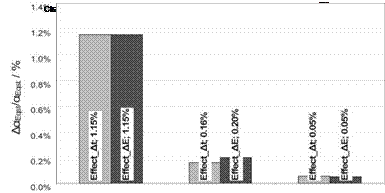Sensitivity Analysis by a Global Variation in Structural Parameters
The variation of the wall thickness and Young’s modulus causes a deviation of stiffness qualities of the wing structure. Due to manipulation of structural properties the tendency of the wing is affected to exceed its shape under a certain load. The objective of the parameter study was to estimate the impact of parameter variation within the main structural components on the structural behavior as well as on the static aeroelastic response.
The alteration of structural parameters of skin, spars, or ribs influences the torsion and bending distortions in different ways. Reduction of the wall thickness as well as of the Young’s modulus in the skin parts has the highest effect on the bending and shear stiffness of the wing reducing the bending moment of inertia and shear coefficient of a local wing box cross-section. The torsional stiffness is also affected, depending on the ratio of wing box height to depth and thickness ratio of the skin to spar webs. Reduction of structural parameters in the spar webs influences mainly the torsional and shear stiffness having only a secondary effect on the bending moment of inertia. Due to the low contribution of the ribs to the bending and torsional
|
Fig. 7 Random input parameter distribution and limit state functions in the normal variable space |
stiffness of the wing box structure the variation of the input parameters in this structural member has only a marginal effect on the deformation behavior of the wing.
A parameter study is carried out to estimate the sensitivity of the structural and thus of the static aeroelastic response relative to the components of the wing structure affected by uncertain input parameters. The influence of each component is estimated by changing successively the wall thickness and Young’s modulus of the skin, spar webs and ribs. To avoid local effects both input parameters are varied simultaneously by ±10% along the wing span. A structural and an aeroelastic response of a modified structure are determined for a reference loading corresponding to the 1g load case. From the structural response, the global deviations [Л0], [Aw’} and [Aael] of torsion deformation, bending angle and elastic angle of attack including the components [AOtr] and [Aw’tr] are calculated. An alteration AaEqSt / aEqSt of the converged angle of attack is obtained from the results of coupled analysis by comparison with the reference structure. The results for the global deviations are given in tables 4 and 5.
The wing box investigated in the parameter study which structural properties are varied separately and in the same manner does not represent a real wing. An actual wing structure is assembled of many different parts of which the dimensions and material properties vary independently from each other. The intent of this simple
|
Table 4 Deviations of bending angle, twist and elastic angle of attack caused by reduction of skin thickness by 10% skin spars
|
|
Table 5 Deviations of bending angle, twist and elastic angle of attack caused by reduction of Young’s modulus by 10% skin spars
|
approach is only to estimate the main trend of the deviation of the output parameters depending on the component of the structure in which the variation of input parameter occurs.
To estimate the tendency of change of the equilibrium state angle of attack aEqSt caused by the input variation of structural components a static aeroelastic response is calculated for each modified structural model already described. The relative deviation of this angle is plotted in fig. 8 for each model derivate. The results show a good agreement with the tendencies obtained from the simple deformation study (see tables 4 and 5). The contribution of deviation of both deformation components to A aEqSt / aEqSt is somehow different for the variation of structural parameters in spar webs and rib surfaces. The change of the torsion angle is negative with respect to the sign convention showing therefore a stiffer torsional behavior. This tendency is due to the skewed root rib of a swept wing which influences the warping moment of inertia and, thus, the torsional behavior of the wing box.
 |
A variation of the structural parameters shows the highest effect on the structure’s stiffness and therewith on the change of the angle of attack in the skin areas as expected. The results of the structural response show that, in spite of a rather high ratio of the torsion angle to the elastic angle of attack, the latter is still dominated by the angle of bending deformation. The almost identical values obtained for A aEqSt /aEqSt by variation of both parameters of the skin parts should be treated as a special case taking into account the global character of the applied variations.
Fig. 8 Random input parameter distribution and limit state functions in the normal variable space












